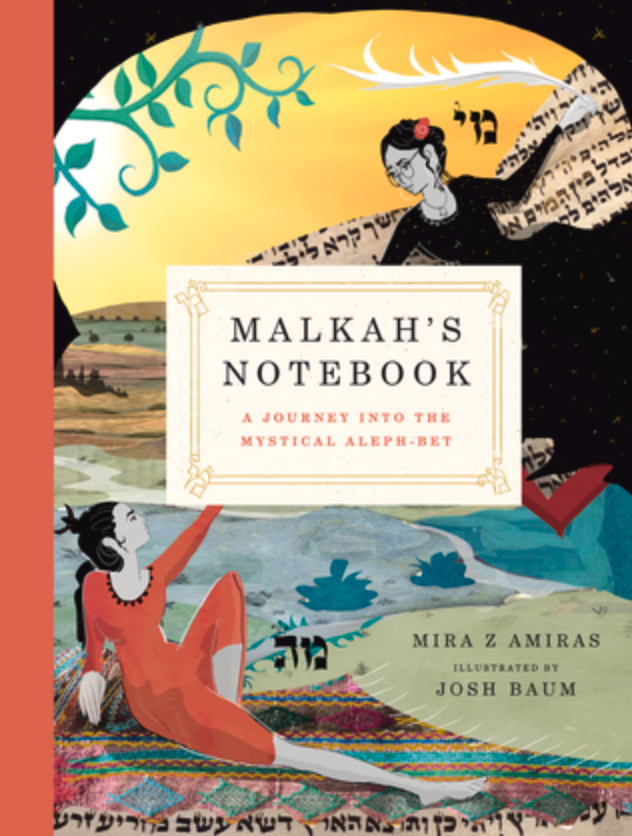Malkah’s Notebook: A Journey into the Mystical Aleph-Bet Is an Inspiring Celebration of the Hebrew Alphabet
Reviewed by Eugenia Koukounas
Malkah’s Notebook: A Journey Into The Mystical Aleph-Bet by Mira Amiras, illustrated by Josh Baum (The Collective Book Studio, 2022) is an inspiring celebration of the Hebrew alphabet: sumptuous, four-color through, with sensitively rendered artwork of a girl who lost her mother at a young age growing into womanhood, as well as the dreamlike visions she has of each Hebrew letter. While the book is geared to a young reader, it’s a joy to read as an adult because it takes challenging concepts addressed in the Torah and makes them simple enough for a child or an adult to comprehend and take to heart.
Malkah’s father, who loves pondering problems because they lead to questions, and questions always open doors, encourages Malkah to begin at the beginning. While reading the first sentence in the Torah, “In the beginning G-d created. . .” she stumbles because the phrase is followed by the letters aleph and tav. She eventually puzzles out, since aleph-tav represents the entire alphabet, she can read that sentence as “In the beginning, G-d created the Aleph Bet.”
She begins to understand that “letters make words, and words tell stories, all stories,” and that they could make just about anything happen. To which her father replies, “Abra-c’dabra!”–abra meaning “I create,” and c’dabra, “as I speak.”
She begs her father to tell her one of her favorite stories about the four sages in paradise–pardes–“orchard” in Hebrew. The Hebrew spelling of pardes, pey, resh, daleth, and samech, describes how each sage approached paradise. Peystands for pshat, meaning “simple”. So the first sage superficially communes with nature. Resh stands for remez, which means “clue,” so the second sage searches for paradise analytically, finding meaning in everything and getting totally lost. Since daleth stands for drash, meaning “seeking,” the third tries to reach paradise experientially through inner seeking; but he climbs so high that he falls and dies. Finally, samech stands for sod, the hidden place where mysteries reside. The fourth sage seeks wisdom mystically and gently acquires it in peace.
On the verge of womanhood, Malkah decides to travel the world to learn about other cultures, during which she goes through a transition, not unlike that of the four sages. First, she communes with nature, taking in everything on a superficial level. Then she strives for knowledge analytically, working as a scholar. The third path she takes is searching through experience, and the fourth, mystically via meditation doesn’t work either. Instead, she finds a community of women out in the desert who teach her how to sing, dance, work and pray, and she comes into her own.
Malkah never abandons her love of Hebrew letters. The author, Mira Amiras, describes her as “a dreamer, a decoder, and an avatar of letters.”
One by one, Malkah discovers what each letter means to her and how much she loves what it represents–the three Mother Letters of fire, water, and air, the seven Double Letters, and twelve Elemental Letters. Each letter demonstrates a principle to guide us on how to live a righteous life.
I love this book and I must confess that I cannot part with my copy, so I’m buying one for my grandson’s birthday, which is coming up soon. I heartily recommend it to you as well. It’s a compelling tale, and it will repay any attention you give it a dozen times over.
Eugenia Koukounas, the author of Searching for Grace: A Pandemic Meditation on the Hebrew Alphabet and All Our Relations: One Path to Devotional Practice, teaches Universal Kabbalah in Northern New Jersey.






